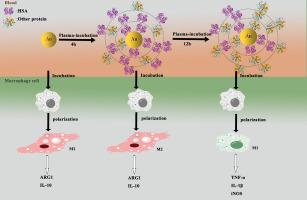International Journal of Biological Macromolecules ( IF 7.7 ) Pub Date : 2021-09-20 , DOI: 10.1016/j.ijbiomac.2021.09.081 Huayan Yang 1 , Sijia Lu 1 , Shengkun Wang 1 , Lihong Liu 1 , Bo Zhu 1 , Shaoning Yu 2 , Shouning Yang 1 , Junbiao Chang 1

|
When nanoparticles (NPs) come into contact with bioenvironments, a protein corona forms on the NP surface. Previous reports showed that the constituents of the corona change with time. However, how different protein corona compositions influence cells, especially immune cells, has received less attention. Macrophages are important immune cells that can be polarized into a pro-inflammatory (M1) or anti-inflammatory (M2) phenotype. In this study, AuNPs were incubated with human plasma for different periods to obtain time-related AuNP-coronas, and the influences of time-related AuNP-coronas on macrophage polarization were investigated. The macrophage morphology, biomarkers, cytokine secretion studies show that the pristine AuNPs and 4 h-AuNP-corona induced macrophage cells into M2 phenotype, while the co-incubation of 12 h-AuNP-corona and macrophage cells result in M1 phenotype. Further proteomic analysis showed that the compositions of protein corona were changing constantly after AuNPs contacted with plasma. When the incubation time increased to 12 h, the immune proteins in protein corona were increased significantly, which play a key role in modulation of the different macrophages polarization. Our findings demonstrated that plasma incubation time is an important parameter that needs to be taken into account in the study of nano-immune interactions and safe use of NPs in biological systems. Moreover, our finding can be a new efficient strategy for activating inflammatory or anti-inflammatory in medical treatment.
中文翻译:

蛋白质电晕的进化影响巨噬细胞极化
当纳米颗粒 (NP) 与生物环境接触时,会在 NP 表面形成蛋白质电晕。先前的报告显示,日冕的成分随时间而变化。然而,不同的蛋白质冠状成分如何影响细胞,尤其是免疫细胞,却很少受到关注。巨噬细胞是重要的免疫细胞,可以极化为促炎 (M1) 或抗炎 (M2) 表型。本研究将AuNPs与人血浆孵育不同时间以获得时间相关的AuNP-coronas,并研究了时间相关的AuNP-coronas对巨噬细胞极化的影响。巨噬细胞形态、生物标志物、细胞因子分泌研究表明,原始 AuNPs 和 4 h-AuNP-corona 诱导巨噬细胞进入 M2 表型,而 12 h-AuNP-电晕和巨噬细胞的共同培养导致 M1 表型。进一步的蛋白质组学分析表明,AuNPs 与血浆接触后,蛋白质电晕的组成不断变化。当孵育时间增加到 12 h 时,蛋白冠中的免疫蛋白显着增加,这在调节不同巨噬细胞极化中起关键作用。我们的研究结果表明,血浆孵育时间是研究纳米免疫相互作用和纳米颗粒在生物系统中安全使用时需要考虑的重要参数。此外,我们的发现可以成为在医学治疗中激活炎症或抗炎的一种新的有效策略。进一步的蛋白质组学分析表明,AuNPs 与血浆接触后,蛋白质电晕的组成不断变化。当孵育时间增加到 12 h 时,蛋白冠中的免疫蛋白显着增加,这在调节不同巨噬细胞极化中起关键作用。我们的研究结果表明,血浆孵育时间是研究纳米免疫相互作用和纳米颗粒在生物系统中安全使用时需要考虑的重要参数。此外,我们的发现可以成为在医学治疗中激活炎症或抗炎的一种新的有效策略。进一步的蛋白质组学分析表明,AuNPs 与血浆接触后,蛋白质电晕的组成不断变化。当孵育时间增加到 12 h 时,蛋白冠中的免疫蛋白显着增加,这在调节不同巨噬细胞极化中起关键作用。我们的研究结果表明,血浆孵育时间是研究纳米免疫相互作用和纳米颗粒在生物系统中安全使用时需要考虑的重要参数。此外,我们的发现可以成为在医学治疗中激活炎症或抗炎的一种新的有效策略。在不同巨噬细胞极化的调节中起关键作用。我们的研究结果表明,血浆孵育时间是研究纳米免疫相互作用和纳米颗粒在生物系统中安全使用时需要考虑的重要参数。此外,我们的发现可以成为在医学治疗中激活炎症或抗炎的一种新的有效策略。在不同巨噬细胞极化的调节中起关键作用。我们的研究结果表明,血浆孵育时间是研究纳米免疫相互作用和纳米颗粒在生物系统中安全使用时需要考虑的重要参数。此外,我们的发现可以成为在医学治疗中激活炎症或抗炎的一种新的有效策略。











































 京公网安备 11010802027423号
京公网安备 11010802027423号